| |
|
|
|
|
| |
|
MERIT
Fair 2003
|
|
|
| |
|
Overview, Project Abstracts, & Presentation Posters |
|
|
| |
|
Friday, August 15, 2003 |
|
|
| |
|
|
|
|
| |
|
|
|
|
| |
|
MERIT 2003 Student Participants
|
|
|
| |
|
The MERIT Fair is held
at the end of the summer to showcase the research conducted by the
undergraduate students during the summer. This forum provides them
with the opportunity to present their work to the wider public.
Their efforts are subjected to scrutiny form a panel of judges selected
from academia, industry, and government laboratories. Winners are
selected in each of the three areas of technical focus: ICE, PEER,
and RITE. The prize winning projects are listed just below with
a complete listing of all MERIT 2003 projects after that. |
|
|
| |
|
|
|
|
| |
|
MERIT
Fair 2003 Prize Winning Projects |
|
|
| |
|
|
|
|
| |
|
|
|
|
| |
|
Internships in Computer Engineering (ICE) |
|
|
| |
|
|
|
|
| |
|
Power
and Energy Electronics Research (PEER) |
|
|
| |
|
|
|
|
| |
|
Research Internships in Telecommunications Engineering (RITE) |
|
|
| |
|
|
|
|
| |
|
|
|
|
| |
|
ICE Projects |
|
|
| |
|
|
|
|
|
|
Modeling the Yeast Cell with
State Machines
Hooman Ahmandi (University
of Maryland at College Park)
Faculty Mentor: Prof. John Baras (University of Maryland at College Park)
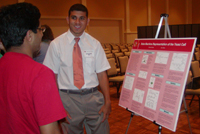 With the
discovery of the human genome and several other genomes, attention
in biology has turned to the more challenging problem of using
DNA information, combined with other information such as dynamics
of cellular process, to deduce how multi-cellular organisms function.
The purpose of the project is to model and link the behavior of
a simple Eukaryotic yeast cell from the metabolic pathways to
the DNA by using electrical engineering techniques. The different
levels of behavior (metabolism, Kreb cycle, DNA transcription/translation,
and gene interactions) are modeled using finite state machines.
These correlations are essential to unraveling the structure and
synthesis of biological systems. With the
discovery of the human genome and several other genomes, attention
in biology has turned to the more challenging problem of using
DNA information, combined with other information such as dynamics
of cellular process, to deduce how multi-cellular organisms function.
The purpose of the project is to model and link the behavior of
a simple Eukaryotic yeast cell from the metabolic pathways to
the DNA by using electrical engineering techniques. The different
levels of behavior (metabolism, Kreb cycle, DNA transcription/translation,
and gene interactions) are modeled using finite state machines.
These correlations are essential to unraveling the structure and
synthesis of biological systems.
Poster Presentation
|
|
|
| |
|
Analysis of Compression
Algorithms for Program Data
Matthew Simpson (Purdue University)
Project Mentors: Prof. Rajeev Barua
(University of Maryland at College Park)
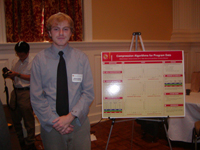 Insufficient
available memory in an application-specific embedded system is
a critical problem affecting the reliability and performance of
devices. A novel solution for dealing with this issue is to compress
blocks of memory infrequently accessed when the system runs out
of memory, and to decompress the memory when needed again, thus
freeing memory for reallocation. In order to determine an appropriate
compression technique for this purpose, a variety of compression
algorithms were studied, several of which were subsequently implemented
and evaluated based both on efficiency in speed and compression
ability of actual program data. Insufficient
available memory in an application-specific embedded system is
a critical problem affecting the reliability and performance of
devices. A novel solution for dealing with this issue is to compress
blocks of memory infrequently accessed when the system runs out
of memory, and to decompress the memory when needed again, thus
freeing memory for reallocation. In order to determine an appropriate
compression technique for this purpose, a variety of compression
algorithms were studied, several of which were subsequently implemented
and evaluated based both on efficiency in speed and compression
ability of actual program data.
Poster Presentation
|
|
|
|
|
RF Effects on Chip-to-Chip Communications
Kun Lin (University of Maryland at
College Park) and Christopher Picardo
(Notre Dame)
Faculty Mentor: Prof. Bruce Jacob
(University of Maryland at College Park)
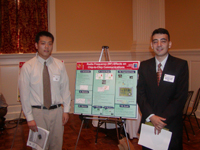 Little is known about the behavior of Integrated Circuits (IC)
working under the influence of Electromagnetic Interference (EMI).
Furthermore, the engineering community lacks software tools capable
of testing ICs under EMI (e.g. SPICE). Simulating EMI on designs
of ICs, before they are constructed, will simplify their design
cycles and implementation. This research concentrates on analyzing
the effects of Radio Frequency (RF) on the normal functionality
of commercially available ICs (e.g. CMOS). Two systems were constructed,
synchronous and asynchronous, to observe system-level (chip-to-chip
communication) and individual IC reactions to RF signals. This
experiment is the first step leading to a more elaborate study
on RF.
Little is known about the behavior of Integrated Circuits (IC)
working under the influence of Electromagnetic Interference (EMI).
Furthermore, the engineering community lacks software tools capable
of testing ICs under EMI (e.g. SPICE). Simulating EMI on designs
of ICs, before they are constructed, will simplify their design
cycles and implementation. This research concentrates on analyzing
the effects of Radio Frequency (RF) on the normal functionality
of commercially available ICs (e.g. CMOS). Two systems were constructed,
synchronous and asynchronous, to observe system-level (chip-to-chip
communication) and individual IC reactions to RF signals. This
experiment is the first step leading to a more elaborate study
on RF.
Poster Presentation
|
|
|
| |
|
Building Hard Random SAT Benchmarks
Jane Lin (University of Maryland
at College Park) and Matthew Schmidt
(Purdue University)
Project Mentors: Prof. Gang Qu (University
of Maryland at College Park)
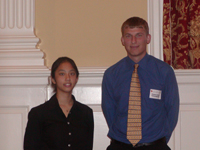 The
only factor known to correlate with the difficulty of solving
the SAT formula in random satisfiability (SAT) problems is the
clause to variable ratio. We investigated the impact of the number
and distribution of solutions to the hardness of SAT problems.
The numbers of backtracks and decisions that a standard Davis-Putnam
solver makes while solving the problem are used to measure the
SAT problem's hardness. The challenge of this project was how
to create random SAT formulas with solutions of specific characteristics.
This study revealed what makes a benchmark difficult and consequently
will help to build a better (and harder) SAT benchmark for testing
the numerous SAT solvers. The
only factor known to correlate with the difficulty of solving
the SAT formula in random satisfiability (SAT) problems is the
clause to variable ratio. We investigated the impact of the number
and distribution of solutions to the hardness of SAT problems.
The numbers of backtracks and decisions that a standard Davis-Putnam
solver makes while solving the problem are used to measure the
SAT problem's hardness. The challenge of this project was how
to create random SAT formulas with solutions of specific characteristics.
This study revealed what makes a benchmark difficult and consequently
will help to build a better (and harder) SAT benchmark for testing
the numerous SAT solvers.
Poster Presentation
|
|
|
| |
|
Prioritized Simultaneous
Multithreading
Daniel Cardy (University of Maryland)
and Hassan Chafi (University of Maryland)
Project Mentors: Prof. Don Yeung
(University of Maryland at College Park)
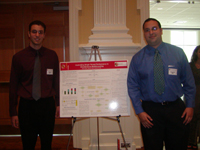 Previous
work in simultaneous multithreading (SMT), a technique permitting
several independent threads to issue instructions in the same
clock cycle, has focused primarily on increasing the total instructions
per cycle (IPC). While this is desirable in some application domains,
SMT will be more attractive if it can adapt to a variety of computing
environments. For instance, some systems are more concerned with
making sure an interactive task runs quickly than with the overall
throughput of the processor. This research demonstrates a variable
priority scheme that affects an individual thread's IPC while
still seeking to maintain the instruction throughput advantages
of an SMT. Previous
work in simultaneous multithreading (SMT), a technique permitting
several independent threads to issue instructions in the same
clock cycle, has focused primarily on increasing the total instructions
per cycle (IPC). While this is desirable in some application domains,
SMT will be more attractive if it can adapt to a variety of computing
environments. For instance, some systems are more concerned with
making sure an interactive task runs quickly than with the overall
throughput of the processor. This research demonstrates a variable
priority scheme that affects an individual thread's IPC while
still seeking to maintain the instruction throughput advantages
of an SMT.
Poster Presentation
|
|
|
| |
|
|
|
|
| |
|
PEER Projects |
|
|
| |
|
|
|
|
|
|
Improvement of SiC Mobility for
Device Simulation
Steve Risner (University
of Maryland at College Park)
Faculty Mentor: Prof. Neil Goldsman
(UMCP) and Dr. Aivars Lelis (Army Research Laboratory)
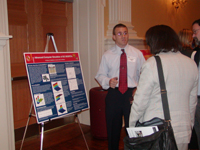 Silicon Carbide (SiC) metal oxide semiconductor field effect transistors (MOSFETs) represent a new technology that can revolutionize the microelectronics industry. Currently, most high-technology electronics are composed of MOSFETs. With the emergence of SiC MOSFETs, the potential exists to extend this high-tech revolution to high temperature and high power electronics. However, the new SiC MOSFETs are not sufficiently reliable for commercial applications. An accurate device simulator is needed to improve the technology. University of Maryland researchers have developed a sophisticated device simulator for SiC MOSFETs which we attempted to improve by examining the accuracy of the numerical solver and its physical parameters. In addition, we adapted an enhanced recombination model that simulates interface trap tunneling. Silicon Carbide (SiC) metal oxide semiconductor field effect transistors (MOSFETs) represent a new technology that can revolutionize the microelectronics industry. Currently, most high-technology electronics are composed of MOSFETs. With the emergence of SiC MOSFETs, the potential exists to extend this high-tech revolution to high temperature and high power electronics. However, the new SiC MOSFETs are not sufficiently reliable for commercial applications. An accurate device simulator is needed to improve the technology. University of Maryland researchers have developed a sophisticated device simulator for SiC MOSFETs which we attempted to improve by examining the accuracy of the numerical solver and its physical parameters. In addition, we adapted an enhanced recombination model that simulates interface trap tunneling.
Poster Presentation
|
|
|
|
|
Characterization of Ohm
ic Contacts on P-Type SiC for High Temperature, High Power Applications
Sharon Harmon (UMCP) and Gabriel Olander (University of Florida)
Faculty Mentor: Prof. R. D. Vispute
(UMCP) and Dr. Ken Jones (Army Research Laboratory)
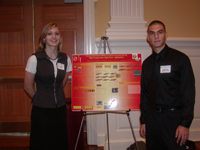 Silicon Carbide (SiC) is a wide band-gap semiconductor highly suitable for high temperature, high power devices. However, the high resistance of Ohmic contacts to p-type SiC has limited their application. Through selective implantation, the SiC is doped with Al and Al/C so that p-type regions exist only where the Ohmic contacts will be made, which in theory provides for a better contact with lower resistance. The high temperature implant annealing requires a capping procedure used to restrict surface-damaging silicon evaporation; however, the surface stoichiometry changes and the surface deteriorates at such temperatures, rendering it useless in device fabrication. Capping SiC with the temperature resistant material AIN protects its stoichiometry at these extreme temperatures. An alternative material for capping, WC, also shows promising physical properties for high-temperature processes. Silicon Carbide (SiC) is a wide band-gap semiconductor highly suitable for high temperature, high power devices. However, the high resistance of Ohmic contacts to p-type SiC has limited their application. Through selective implantation, the SiC is doped with Al and Al/C so that p-type regions exist only where the Ohmic contacts will be made, which in theory provides for a better contact with lower resistance. The high temperature implant annealing requires a capping procedure used to restrict surface-damaging silicon evaporation; however, the surface stoichiometry changes and the surface deteriorates at such temperatures, rendering it useless in device fabrication. Capping SiC with the temperature resistant material AIN protects its stoichiometry at these extreme temperatures. An alternative material for capping, WC, also shows promising physical properties for high-temperature processes.
Poster Presentation
|
|
|
|
|
High Temperature AIN Dielectrics for Wide Bandgap Power Devices
Jason Hall (The Citadel) and Gabriel Olander (University of Florida)
Faculty Mentor: Prof. R. D. Vispute
(UMCP) and Dr. Aivars Lelis (Army Research Laboratory)
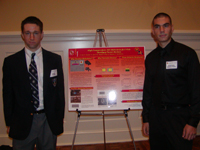 Aluminum nitride thin films deposited by PLD (pulsed laser deposition) and
reactive sputtering have been under investigation for planar dielectric as well as passivation for SiC high temperature and high power device applications. Sputtering parameters such as time, power, and pressure have been studied in an attempt to optimize film characteristics for various applications. Measured film characteristics resulting from varying these processes will be used to numerically model film properties versus process parameters. Relative merits of PLD and sputtering will be compared by contrasting aspect ratio, leakage currents, optical, and interface properties. Using optimized parameters, AlN films will be deposited on SiC and TiN films on AlN to fabricate a MIS (metal-insulator-semiconductor) device. Electrical properties of the MIS device will be conducted to determine it's viability as a high power, high temperature capacitor. Aluminum nitride thin films deposited by PLD (pulsed laser deposition) and
reactive sputtering have been under investigation for planar dielectric as well as passivation for SiC high temperature and high power device applications. Sputtering parameters such as time, power, and pressure have been studied in an attempt to optimize film characteristics for various applications. Measured film characteristics resulting from varying these processes will be used to numerically model film properties versus process parameters. Relative merits of PLD and sputtering will be compared by contrasting aspect ratio, leakage currents, optical, and interface properties. Using optimized parameters, AlN films will be deposited on SiC and TiN films on AlN to fabricate a MIS (metal-insulator-semiconductor) device. Electrical properties of the MIS device will be conducted to determine it's viability as a high power, high temperature capacitor.
Poster Presentation
|
|
|
|
|
Developing AIN Based MEMS/NEMS RF Resonators
Andrew Herson (UMCP) and John Koster (Bowdoin College)
Faculty Mentor: Prof. R. D. Vispute
(UMCP) and Dr. Alma Wickenden (Army Research Laboratory)
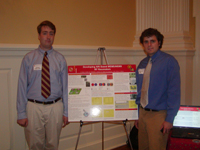 MEMS technology is being explored for implementation in micro and nano-sized electronics. In particular, AlN-based resonator elements, which can operate at extremely high frequencies, are being developed for RF filters. Resonator fabrication incorporates the growth and etches of material layers processed on silicon wafers. This summer, the growth of high quality piezoelectric AlN films by pulsed laser deposition (PLD) was optimized, and the intricacies encompassing the fabrication of MEMS/NEMS resonators were explored. The effect of various BCl3, Cl2 and Ar combinations on the material layers, AlN, Pt, SiO2 and Si, was measured for the anisotropic etch rate and sidewall angle. Prototype resonator devices were made and tested to evaluate device performance. MEMS technology is being explored for implementation in micro and nano-sized electronics. In particular, AlN-based resonator elements, which can operate at extremely high frequencies, are being developed for RF filters. Resonator fabrication incorporates the growth and etches of material layers processed on silicon wafers. This summer, the growth of high quality piezoelectric AlN films by pulsed laser deposition (PLD) was optimized, and the intricacies encompassing the fabrication of MEMS/NEMS resonators were explored. The effect of various BCl3, Cl2 and Ar combinations on the material layers, AlN, Pt, SiO2 and Si, was measured for the anisotropic etch rate and sidewall angle. Prototype resonator devices were made and tested to evaluate device performance.
Poster Presentation
|
|
|
| |
|
|
|
|
| |
|
RITE Projects |
|
|
| |
|
|
|
|
|
|
Cell Clinics: Amplification
of Responses from Electrically Active Cells Using a Bioamplifier
Jack Chaiyupatumpa (University
of Maryland at College Park)
Kory Schoenfliess (University of Maryland, Baltimore County)
Faculty Mentor: Pamela Abshire (UMCP)
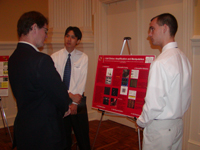 Cell clinics are microstructures for capture and characterization of single cells. We investigated techniques for interface to electrically active cells. The extra cellular response is a small signal (= 5 mV) with spectral content at frequencies up to 8 kHz. Our integrated Bioamplifier provides gains of 20, 40, or 100 to measure such small signals. It is a transconductance amplifier with capacitive feedback. We performed extensive testing to verify the gain and frequency response. In addition, we constructed test fixtures and cultured bovine aortic smooth muscle cells (BAOSMC) to test the Bioamplifier. We also experimented with methods for cell manipulation, including dielectrophoresis and micro-pipetting. Cell clinics are microstructures for capture and characterization of single cells. We investigated techniques for interface to electrically active cells. The extra cellular response is a small signal (= 5 mV) with spectral content at frequencies up to 8 kHz. Our integrated Bioamplifier provides gains of 20, 40, or 100 to measure such small signals. It is a transconductance amplifier with capacitive feedback. We performed extensive testing to verify the gain and frequency response. In addition, we constructed test fixtures and cultured bovine aortic smooth muscle cells (BAOSMC) to test the Bioamplifier. We also experimented with methods for cell manipulation, including dielectrophoresis and micro-pipetting.
Poster Presentation
|
|
|
|
|
Neural Spike Detection Using
Low-Power Chip Design
David Sander (Pennsylvania State University)
Thomas Swindell (University of Maryland at College Park)
Faculty Mentor: Prof. Pamela Abshire
(UMCP) and Prof. Timmer Horiuchi (UMCP)
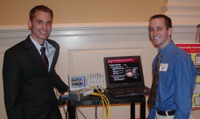 Current methods of recording neural activity have several obstacles that must be overcome before massively-parallel multi-electrode recordings can become a reality. The limitations span from using electrodes with individual wires and bulky remote amplifiers that require restraining the specimen, to interpretation of received data. Acquiring and processing data must become easier to manage and automate for more channels of data to be read simultaneously. Our project tested and refined a low-power chip designed for implantation on a small, freely-moving animal. The chip performs amplification, filtering, and spike detection of neural signals and was tested using real-life neural signals from blowflies. Current methods of recording neural activity have several obstacles that must be overcome before massively-parallel multi-electrode recordings can become a reality. The limitations span from using electrodes with individual wires and bulky remote amplifiers that require restraining the specimen, to interpretation of received data. Acquiring and processing data must become easier to manage and automate for more channels of data to be read simultaneously. Our project tested and refined a low-power chip designed for implantation on a small, freely-moving animal. The chip performs amplification, filtering, and spike detection of neural signals and was tested using real-life neural signals from blowflies.
Poster Presentation
|
|
|
|
|
Computer Face Recognition
Nathan Koterba (University
of Maryland at College Park)
Faculty Mentor: Prof. Rama Chellappa
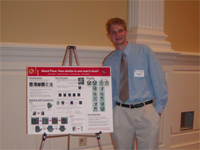 Isolating and identifying faces in still and moving images is extremely difficult assume. Research has shown that variances in lighting, pose, and age can drastically hinder the effectiveness of face recognition algorithms. This summer, I helped research to what degree these variances can alter and disguise a person's identity in the eyes of a computer. Using a standard Principal Component Analysis (PCA) algorithm and 3d models when necessary, the similarity between a base image and various "probe" images was determined. The collected data supported many of the current assumptions, but also provided a general ordering of variation influence. Isolating and identifying faces in still and moving images is extremely difficult assume. Research has shown that variances in lighting, pose, and age can drastically hinder the effectiveness of face recognition algorithms. This summer, I helped research to what degree these variances can alter and disguise a person's identity in the eyes of a computer. Using a standard Principal Component Analysis (PCA) algorithm and 3d models when necessary, the similarity between a base image and various "probe" images was determined. The collected data supported many of the current assumptions, but also provided a general ordering of variation influence.
Poster Presentation
|
|
|
|
|
Measure of Periodicity and
Aperiodicity in Speech Signals
Jawahar Singh (University of Maryland
at College Park)
Faculty Mentor: Prof. Carol Espy-Wilson
(UMCP)
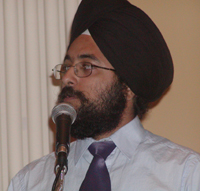 The present periodicity/aperiodicity detector estimates the proportion
of periodic and aperiodic energy present in a speech signal. In
particular, the outputs from the 60 frequency channels of an auditory
gamma-tone filterbank are used to make a binary decision regarding
the periodicity and aperiodicity of the signals. In this project,
we measured the degree of periodicity and aperiodicity present
in each channel based on the relative number, strength and distribution
of the minima of the Average Magnitude Difference Function (AMDF)
computed. In this way, a channel output can be judged to be both
periodic and aperiodic. The performance of this algorithm was
evaluated on synthetic and natural speech data.
The present periodicity/aperiodicity detector estimates the proportion
of periodic and aperiodic energy present in a speech signal. In
particular, the outputs from the 60 frequency channels of an auditory
gamma-tone filterbank are used to make a binary decision regarding
the periodicity and aperiodicity of the signals. In this project,
we measured the degree of periodicity and aperiodicity present
in each channel based on the relative number, strength and distribution
of the minima of the Average Magnitude Difference Function (AMDF)
computed. In this way, a channel output can be judged to be both
periodic and aperiodic. The performance of this algorithm was
evaluated on synthetic and natural speech data.
Poster Presentation
|
|
|
|
|
Creating Articulatory Feature-Based
Finite State Automata for Speech Recognition
Paul Young (University
of Maryland at College Park)
Faculty Mentor: Prof. Carol Espy-Wilson
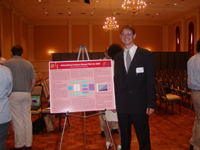 The development of a high performance Automatic Speech Recognition (ASR) system is a challenging problem. One proposed implementation of ASR is the "acoustic-phonetic" approach to speech modeling. This method enables the system to selectively extract low level linguistic information in a speech signal given a speech context. For such a system to function, a Finite State Automata (FSA) must be created that can: (1) maintain a context of articulatory features to be extracted and (2) identify a word after association with a sequence of articulatory features. Our project goal was to build a module that creates a minimized FSA for a lexicon of words. This module includes: (as input) a list of words and their phonetic transcriptions; (as knowledge) a phonetic-to-feature transcription translator; and (as output) an optimized FSA. The development of a high performance Automatic Speech Recognition (ASR) system is a challenging problem. One proposed implementation of ASR is the "acoustic-phonetic" approach to speech modeling. This method enables the system to selectively extract low level linguistic information in a speech signal given a speech context. For such a system to function, a Finite State Automata (FSA) must be created that can: (1) maintain a context of articulatory features to be extracted and (2) identify a word after association with a sequence of articulatory features. Our project goal was to build a module that creates a minimized FSA for a lexicon of words. This module includes: (as input) a list of words and their phonetic transcriptions; (as knowledge) a phonetic-to-feature transcription translator; and (as output) an optimized FSA.
Poster Presentation
|
|
|
|
|
An Echolocating BatMobile
Jesse Clark (University of Maryland
at College Park) and Patrick Knapp
(Syracuse University)
Faculty Mentor: Prof. Timothy Horiuchi
(University of Maryland at College Park)
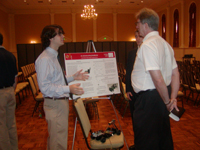 The goal of our project was to design and build a model car that can avoid objects using sonar. Our research began by studying bats' usage of echolocation to seek or to avoid objects. We utilized the technology of PIC programmable microchips to implement the Interaural Level Difference (ILD) method for echolocation and a steering algorithm. The car consists of two microphones and a speaker, which serve as ears and voice respectively. The speaker emits a high frequency pulse to which the microphones are tuned. The received signals of the two microphones are then compared, and the data is sent through the steering algorithm, which finally controls the servo steering device to move the car away from obstacles.
The goal of our project was to design and build a model car that can avoid objects using sonar. Our research began by studying bats' usage of echolocation to seek or to avoid objects. We utilized the technology of PIC programmable microchips to implement the Interaural Level Difference (ILD) method for echolocation and a steering algorithm. The car consists of two microphones and a speaker, which serve as ears and voice respectively. The speaker emits a high frequency pulse to which the microphones are tuned. The received signals of the two microphones are then compared, and the data is sent through the steering algorithm, which finally controls the servo steering device to move the car away from obstacles.
Poster Presentation
|
|
|
|
|
GPS Feedback Control of Robot
Adrian Cottin (University of Maryland
at College Park)
Ronald Ng (University of Maryland
at College Park)
Faculty Mentor: Prof. P. S. Krishnaprasad
(University of Maryland at College Park)
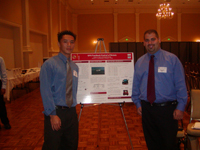 The purpose of our research was to integrate the Global Positioning System into motion control of nonholonomic robots using the Motion Description Language (MDLe) developed in the Intelligent Servosystems Laboratory. The robots used in our research were capable of all-terrain work. First, an instruction plan created to navigate through a series of mapped waypoints at University of Maryland Mall was tested using landmark (campus buildings) based navigation. In addition, GPS was integrated into a second robot to prepare it for working and maintaining a two robot formation using GPS, a ranging laser, sonars, and a camera.
The purpose of our research was to integrate the Global Positioning System into motion control of nonholonomic robots using the Motion Description Language (MDLe) developed in the Intelligent Servosystems Laboratory. The robots used in our research were capable of all-terrain work. First, an instruction plan created to navigate through a series of mapped waypoints at University of Maryland Mall was tested using landmark (campus buildings) based navigation. In addition, GPS was integrated into a second robot to prepare it for working and maintaining a two robot formation using GPS, a ranging laser, sonars, and a camera.
Poster Presentation
|
|
|
|
|
Implementing Indoor Wireless Geolocation System Using Smart Antenna Array
Deborah Chang (University of Maryland
at College Park)
Hung-Quoc Lai (University of Maryland
at College Park)
Faculty Mentor: Prof. Fay Liu (University
of Maryland at College Park)
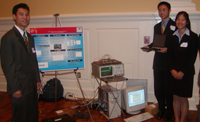 As the field of wireless geolocation continues to grow, the need for more accurate indoor systems for situations such as locating the caller of an E-911 call has become imperative. This research project focused on assembling and configuring a multiple receiver antenna array to better estimate the location of a wireless transmitter. First, a prototype comprised of an antenna array receiver and a data acquisition system was constructed. Then the FPGA architecture was modified to collect data synchronously. Finally, communications algorithms, such as MUSIC, provided a means to estimate the angle of arrival of a signal emanating from a transmitter. The resulting system not only has the potential to improve indoor geolocation but also to enhance several other exciting applications such as digital beamforming.
As the field of wireless geolocation continues to grow, the need for more accurate indoor systems for situations such as locating the caller of an E-911 call has become imperative. This research project focused on assembling and configuring a multiple receiver antenna array to better estimate the location of a wireless transmitter. First, a prototype comprised of an antenna array receiver and a data acquisition system was constructed. Then the FPGA architecture was modified to collect data synchronously. Finally, communications algorithms, such as MUSIC, provided a means to estimate the angle of arrival of a signal emanating from a transmitter. The resulting system not only has the potential to improve indoor geolocation but also to enhance several other exciting applications such as digital beamforming.
Poster Presentation
|
|
|
|
|
Wireless Communication Over Fading
Channels
M'baye Diao (Syracuse University)
Tony Price (Clark Atlanta University)
Faculty Mentor: Prof. Prakash Narayan
(University of Maryland at College Park)
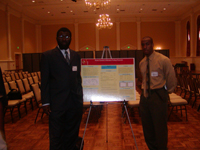 Wireless communication systems must cope with the challenge of multipath fading, interference, and time-and frequency selectivity. Since each user is allocated only a limited amount of power, dynamic channel allocation can be used to reduce interference from frequency reuse. The determination of efficient power control strategies in time varying fading channels is an area of active research. In practice, the channel state (fade) may or may not be accurately estimated at the transmitter or the receiver site. We made assumptions on the distributions of the fades and maximized the mutual information (channel capacity) subject to an average input power constraint with causal channel state information (CSI). Additionally, we attempted to maximize mutual information with respect to signal to noise ratio (SNR).
Wireless communication systems must cope with the challenge of multipath fading, interference, and time-and frequency selectivity. Since each user is allocated only a limited amount of power, dynamic channel allocation can be used to reduce interference from frequency reuse. The determination of efficient power control strategies in time varying fading channels is an area of active research. In practice, the channel state (fade) may or may not be accurately estimated at the transmitter or the receiver site. We made assumptions on the distributions of the fades and maximized the mutual information (channel capacity) subject to an average input power constraint with causal channel state information (CSI). Additionally, we attempted to maximize mutual information with respect to signal to noise ratio (SNR).
Poster Presentation
|
|
|
|
|
Auditory Stream Segregation in Ferrets
Parissa Farahifar (University of
Maryland at College Park)
Faculty Mentor: Prof. Shihab Shamma
(University of Maryland at College Park)
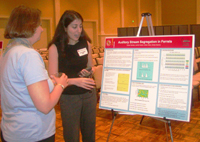 When a sequence of two temporally interleaved pure tones of different frequencies is heard above a certain rate and with a sufficiently large frequency separation, humans perceptually segregate them into 2 different objects or "streams". We recorded action potentials in response to two interleaved tone sequences, having a range of frequency separation, to determine if there is evidence of stream segregation at the level of single auditory cortical neurons in ferrets. If correlates of streaming exist, then the neural representation of individual tones of the sequences will undergo a qualitative change for frequency separations that exceed the critical segregation boundary.
When a sequence of two temporally interleaved pure tones of different frequencies is heard above a certain rate and with a sufficiently large frequency separation, humans perceptually segregate them into 2 different objects or "streams". We recorded action potentials in response to two interleaved tone sequences, having a range of frequency separation, to determine if there is evidence of stream segregation at the level of single auditory cortical neurons in ferrets. If correlates of streaming exist, then the neural representation of individual tones of the sequences will undergo a qualitative change for frequency separations that exceed the critical segregation boundary.
Poster Presentation
|
|
|
|
|
Multimedia Watermarking Toolbox
Michelle Mazurek (University of Maryland
at College Park)
Harold Tagunicar (University of Maryland
at College Park)
Faculty Mentor: Prof. Min Wu (University
of Maryland at College Park)
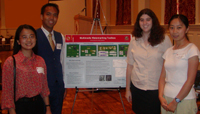 As public access to multimedia files grows, it is increasingly important to protect proprietary information. Digital watermarking - or the hiding of information imperceptibly within multimedia files - has many applications in this area. This project involved developing a basic watermarking toolbox consisting of modular components for use with image and audio files. Added to the core toolbox was the ability to prepare and interpret watermarks specifically for authentication and fingerprinting applications. Other features included noise and attack degradation and detection of collusion attack. The toolbox will provide an expandable, reusable engine facilitating further research and rapid prototyping of digital watermarking.
As public access to multimedia files grows, it is increasingly important to protect proprietary information. Digital watermarking - or the hiding of information imperceptibly within multimedia files - has many applications in this area. This project involved developing a basic watermarking toolbox consisting of modular components for use with image and audio files. Added to the core toolbox was the ability to prepare and interpret watermarks specifically for authentication and fingerprinting applications. Other features included noise and attack degradation and detection of collusion attack. The toolbox will provide an expandable, reusable engine facilitating further research and rapid prototyping of digital watermarking.
Poster Presentation
|
|
|
|
|
Software for Secure Wireless
Multimedia
Raymond DeLuca (Pennsylvania State
University)
Giridhar Nandipati (Pennsylvania
State University))
Faculty Mentor: Prof. Ray Liu (UMCP) and Prof. Min Wu (UMCP)
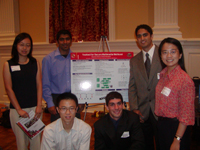 The problems inherent in wireless multimedia communication have been addressed in recent research, and various ideas for preserving security through key management schemes have been developed. Our goal was to create a streaming software prototype that implements a new key management protocol. This protocol ensures that only members can access privileged material, and allows members to change rapidly without delaying the overall system. This system employs a contributory key management scheme to efficiently maintain keys used for encrypting the multicasted multimedia content. We analyzed this system after implementation to test the efficiency of the key management scheme.
The problems inherent in wireless multimedia communication have been addressed in recent research, and various ideas for preserving security through key management schemes have been developed. Our goal was to create a streaming software prototype that implements a new key management protocol. This protocol ensures that only members can access privileged material, and allows members to change rapidly without delaying the overall system. This system employs a contributory key management scheme to efficiently maintain keys used for encrypting the multicasted multimedia content. We analyzed this system after implementation to test the efficiency of the key management scheme.
Poster Presentation
|
|
|
| |
|
|
|
|

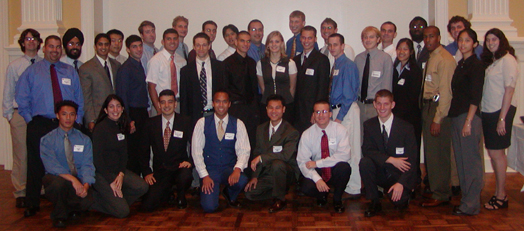
 With the
discovery of the human genome and several other genomes, attention
in biology has turned to the more challenging problem of using
DNA information, combined with other information such as dynamics
of cellular process, to deduce how multi-cellular organisms function.
The purpose of the project is to model and link the behavior of
a simple Eukaryotic yeast cell from the metabolic pathways to
the DNA by using electrical engineering techniques. The different
levels of behavior (metabolism, Kreb cycle, DNA transcription/translation,
and gene interactions) are modeled using finite state machines.
These correlations are essential to unraveling the structure and
synthesis of biological systems.
With the
discovery of the human genome and several other genomes, attention
in biology has turned to the more challenging problem of using
DNA information, combined with other information such as dynamics
of cellular process, to deduce how multi-cellular organisms function.
The purpose of the project is to model and link the behavior of
a simple Eukaryotic yeast cell from the metabolic pathways to
the DNA by using electrical engineering techniques. The different
levels of behavior (metabolism, Kreb cycle, DNA transcription/translation,
and gene interactions) are modeled using finite state machines.
These correlations are essential to unraveling the structure and
synthesis of biological systems. Insufficient
available memory in an application-specific embedded system is
a critical problem affecting the reliability and performance of
devices. A novel solution for dealing with this issue is to compress
blocks of memory infrequently accessed when the system runs out
of memory, and to decompress the memory when needed again, thus
freeing memory for reallocation. In order to determine an appropriate
compression technique for this purpose, a variety of compression
algorithms were studied, several of which were subsequently implemented
and evaluated based both on efficiency in speed and compression
ability of actual program data.
Insufficient
available memory in an application-specific embedded system is
a critical problem affecting the reliability and performance of
devices. A novel solution for dealing with this issue is to compress
blocks of memory infrequently accessed when the system runs out
of memory, and to decompress the memory when needed again, thus
freeing memory for reallocation. In order to determine an appropriate
compression technique for this purpose, a variety of compression
algorithms were studied, several of which were subsequently implemented
and evaluated based both on efficiency in speed and compression
ability of actual program data. Little is known about the behavior of Integrated Circuits (IC)
working under the influence of Electromagnetic Interference (EMI).
Furthermore, the engineering community lacks software tools capable
of testing ICs under EMI (e.g. SPICE). Simulating EMI on designs
of ICs, before they are constructed, will simplify their design
cycles and implementation. This research concentrates on analyzing
the effects of Radio Frequency (RF) on the normal functionality
of commercially available ICs (e.g. CMOS). Two systems were constructed,
synchronous and asynchronous, to observe system-level (chip-to-chip
communication) and individual IC reactions to RF signals. This
experiment is the first step leading to a more elaborate study
on RF.
Little is known about the behavior of Integrated Circuits (IC)
working under the influence of Electromagnetic Interference (EMI).
Furthermore, the engineering community lacks software tools capable
of testing ICs under EMI (e.g. SPICE). Simulating EMI on designs
of ICs, before they are constructed, will simplify their design
cycles and implementation. This research concentrates on analyzing
the effects of Radio Frequency (RF) on the normal functionality
of commercially available ICs (e.g. CMOS). Two systems were constructed,
synchronous and asynchronous, to observe system-level (chip-to-chip
communication) and individual IC reactions to RF signals. This
experiment is the first step leading to a more elaborate study
on RF. The
only factor known to correlate with the difficulty of solving
the SAT formula in random satisfiability (SAT) problems is the
clause to variable ratio. We investigated the impact of the number
and distribution of solutions to the hardness of SAT problems.
The numbers of backtracks and decisions that a standard Davis-Putnam
solver makes while solving the problem are used to measure the
SAT problem's hardness. The challenge of this project was how
to create random SAT formulas with solutions of specific characteristics.
This study revealed what makes a benchmark difficult and consequently
will help to build a better (and harder) SAT benchmark for testing
the numerous SAT solvers.
The
only factor known to correlate with the difficulty of solving
the SAT formula in random satisfiability (SAT) problems is the
clause to variable ratio. We investigated the impact of the number
and distribution of solutions to the hardness of SAT problems.
The numbers of backtracks and decisions that a standard Davis-Putnam
solver makes while solving the problem are used to measure the
SAT problem's hardness. The challenge of this project was how
to create random SAT formulas with solutions of specific characteristics.
This study revealed what makes a benchmark difficult and consequently
will help to build a better (and harder) SAT benchmark for testing
the numerous SAT solvers. Previous
work in simultaneous multithreading (SMT), a technique permitting
several independent threads to issue instructions in the same
clock cycle, has focused primarily on increasing the total instructions
per cycle (IPC). While this is desirable in some application domains,
SMT will be more attractive if it can adapt to a variety of computing
environments. For instance, some systems are more concerned with
making sure an interactive task runs quickly than with the overall
throughput of the processor. This research demonstrates a variable
priority scheme that affects an individual thread's IPC while
still seeking to maintain the instruction throughput advantages
of an SMT.
Previous
work in simultaneous multithreading (SMT), a technique permitting
several independent threads to issue instructions in the same
clock cycle, has focused primarily on increasing the total instructions
per cycle (IPC). While this is desirable in some application domains,
SMT will be more attractive if it can adapt to a variety of computing
environments. For instance, some systems are more concerned with
making sure an interactive task runs quickly than with the overall
throughput of the processor. This research demonstrates a variable
priority scheme that affects an individual thread's IPC while
still seeking to maintain the instruction throughput advantages
of an SMT.  Silicon Carbide (SiC) metal oxide semiconductor field effect transistors (MOSFETs) represent a new technology that can revolutionize the microelectronics industry. Currently, most high-technology electronics are composed of MOSFETs. With the emergence of SiC MOSFETs, the potential exists to extend this high-tech revolution to high temperature and high power electronics. However, the new SiC MOSFETs are not sufficiently reliable for commercial applications. An accurate device simulator is needed to improve the technology. University of Maryland researchers have developed a sophisticated device simulator for SiC MOSFETs which we attempted to improve by examining the accuracy of the numerical solver and its physical parameters. In addition, we adapted an enhanced recombination model that simulates interface trap tunneling.
Silicon Carbide (SiC) metal oxide semiconductor field effect transistors (MOSFETs) represent a new technology that can revolutionize the microelectronics industry. Currently, most high-technology electronics are composed of MOSFETs. With the emergence of SiC MOSFETs, the potential exists to extend this high-tech revolution to high temperature and high power electronics. However, the new SiC MOSFETs are not sufficiently reliable for commercial applications. An accurate device simulator is needed to improve the technology. University of Maryland researchers have developed a sophisticated device simulator for SiC MOSFETs which we attempted to improve by examining the accuracy of the numerical solver and its physical parameters. In addition, we adapted an enhanced recombination model that simulates interface trap tunneling. Silicon Carbide (SiC) is a wide band-gap semiconductor highly suitable for high temperature, high power devices. However, the high resistance of Ohmic contacts to p-type SiC has limited their application. Through selective implantation, the SiC is doped with Al and Al/C so that p-type regions exist only where the Ohmic contacts will be made, which in theory provides for a better contact with lower resistance. The high temperature implant annealing requires a capping procedure used to restrict surface-damaging silicon evaporation; however, the surface stoichiometry changes and the surface deteriorates at such temperatures, rendering it useless in device fabrication. Capping SiC with the temperature resistant material AIN protects its stoichiometry at these extreme temperatures. An alternative material for capping, WC, also shows promising physical properties for high-temperature processes.
Silicon Carbide (SiC) is a wide band-gap semiconductor highly suitable for high temperature, high power devices. However, the high resistance of Ohmic contacts to p-type SiC has limited their application. Through selective implantation, the SiC is doped with Al and Al/C so that p-type regions exist only where the Ohmic contacts will be made, which in theory provides for a better contact with lower resistance. The high temperature implant annealing requires a capping procedure used to restrict surface-damaging silicon evaporation; however, the surface stoichiometry changes and the surface deteriorates at such temperatures, rendering it useless in device fabrication. Capping SiC with the temperature resistant material AIN protects its stoichiometry at these extreme temperatures. An alternative material for capping, WC, also shows promising physical properties for high-temperature processes.  Aluminum nitride thin films deposited by PLD (pulsed laser deposition) and
reactive sputtering have been under investigation for planar dielectric as well as passivation for SiC high temperature and high power device applications. Sputtering parameters such as time, power, and pressure have been studied in an attempt to optimize film characteristics for various applications. Measured film characteristics resulting from varying these processes will be used to numerically model film properties versus process parameters. Relative merits of PLD and sputtering will be compared by contrasting aspect ratio, leakage currents, optical, and interface properties. Using optimized parameters, AlN films will be deposited on SiC and TiN films on AlN to fabricate a MIS (metal-insulator-semiconductor) device. Electrical properties of the MIS device will be conducted to determine it's viability as a high power, high temperature capacitor.
Aluminum nitride thin films deposited by PLD (pulsed laser deposition) and
reactive sputtering have been under investigation for planar dielectric as well as passivation for SiC high temperature and high power device applications. Sputtering parameters such as time, power, and pressure have been studied in an attempt to optimize film characteristics for various applications. Measured film characteristics resulting from varying these processes will be used to numerically model film properties versus process parameters. Relative merits of PLD and sputtering will be compared by contrasting aspect ratio, leakage currents, optical, and interface properties. Using optimized parameters, AlN films will be deposited on SiC and TiN films on AlN to fabricate a MIS (metal-insulator-semiconductor) device. Electrical properties of the MIS device will be conducted to determine it's viability as a high power, high temperature capacitor. MEMS technology is being explored for implementation in micro and nano-sized electronics. In particular, AlN-based resonator elements, which can operate at extremely high frequencies, are being developed for RF filters. Resonator fabrication incorporates the growth and etches of material layers processed on silicon wafers. This summer, the growth of high quality piezoelectric AlN films by pulsed laser deposition (PLD) was optimized, and the intricacies encompassing the fabrication of MEMS/NEMS resonators were explored. The effect of various BCl3, Cl2 and Ar combinations on the material layers, AlN, Pt, SiO2 and Si, was measured for the anisotropic etch rate and sidewall angle. Prototype resonator devices were made and tested to evaluate device performance.
MEMS technology is being explored for implementation in micro and nano-sized electronics. In particular, AlN-based resonator elements, which can operate at extremely high frequencies, are being developed for RF filters. Resonator fabrication incorporates the growth and etches of material layers processed on silicon wafers. This summer, the growth of high quality piezoelectric AlN films by pulsed laser deposition (PLD) was optimized, and the intricacies encompassing the fabrication of MEMS/NEMS resonators were explored. The effect of various BCl3, Cl2 and Ar combinations on the material layers, AlN, Pt, SiO2 and Si, was measured for the anisotropic etch rate and sidewall angle. Prototype resonator devices were made and tested to evaluate device performance. Cell clinics are microstructures for capture and characterization of single cells. We investigated techniques for interface to electrically active cells. The extra cellular response is a small signal (= 5 mV) with spectral content at frequencies up to 8 kHz. Our integrated Bioamplifier provides gains of 20, 40, or 100 to measure such small signals. It is a transconductance amplifier with capacitive feedback. We performed extensive testing to verify the gain and frequency response. In addition, we constructed test fixtures and cultured bovine aortic smooth muscle cells (BAOSMC) to test the Bioamplifier. We also experimented with methods for cell manipulation, including dielectrophoresis and micro-pipetting.
Cell clinics are microstructures for capture and characterization of single cells. We investigated techniques for interface to electrically active cells. The extra cellular response is a small signal (= 5 mV) with spectral content at frequencies up to 8 kHz. Our integrated Bioamplifier provides gains of 20, 40, or 100 to measure such small signals. It is a transconductance amplifier with capacitive feedback. We performed extensive testing to verify the gain and frequency response. In addition, we constructed test fixtures and cultured bovine aortic smooth muscle cells (BAOSMC) to test the Bioamplifier. We also experimented with methods for cell manipulation, including dielectrophoresis and micro-pipetting.
 Current methods of recording neural activity have several obstacles that must be overcome before massively-parallel multi-electrode recordings can become a reality. The limitations span from using electrodes with individual wires and bulky remote amplifiers that require restraining the specimen, to interpretation of received data. Acquiring and processing data must become easier to manage and automate for more channels of data to be read simultaneously. Our project tested and refined a low-power chip designed for implantation on a small, freely-moving animal. The chip performs amplification, filtering, and spike detection of neural signals and was tested using real-life neural signals from blowflies.
Current methods of recording neural activity have several obstacles that must be overcome before massively-parallel multi-electrode recordings can become a reality. The limitations span from using electrodes with individual wires and bulky remote amplifiers that require restraining the specimen, to interpretation of received data. Acquiring and processing data must become easier to manage and automate for more channels of data to be read simultaneously. Our project tested and refined a low-power chip designed for implantation on a small, freely-moving animal. The chip performs amplification, filtering, and spike detection of neural signals and was tested using real-life neural signals from blowflies.
 Isolating and identifying faces in still and moving images is extremely difficult assume. Research has shown that variances in lighting, pose, and age can drastically hinder the effectiveness of face recognition algorithms. This summer, I helped research to what degree these variances can alter and disguise a person's identity in the eyes of a computer. Using a standard Principal Component Analysis (PCA) algorithm and 3d models when necessary, the similarity between a base image and various "probe" images was determined. The collected data supported many of the current assumptions, but also provided a general ordering of variation influence.
Isolating and identifying faces in still and moving images is extremely difficult assume. Research has shown that variances in lighting, pose, and age can drastically hinder the effectiveness of face recognition algorithms. This summer, I helped research to what degree these variances can alter and disguise a person's identity in the eyes of a computer. Using a standard Principal Component Analysis (PCA) algorithm and 3d models when necessary, the similarity between a base image and various "probe" images was determined. The collected data supported many of the current assumptions, but also provided a general ordering of variation influence.
 The present periodicity/aperiodicity detector estimates the proportion
of periodic and aperiodic energy present in a speech signal. In
particular, the outputs from the 60 frequency channels of an auditory
gamma-tone filterbank are used to make a binary decision regarding
the periodicity and aperiodicity of the signals. In this project,
we measured the degree of periodicity and aperiodicity present
in each channel based on the relative number, strength and distribution
of the minima of the Average Magnitude Difference Function (AMDF)
computed. In this way, a channel output can be judged to be both
periodic and aperiodic. The performance of this algorithm was
evaluated on synthetic and natural speech data.
The present periodicity/aperiodicity detector estimates the proportion
of periodic and aperiodic energy present in a speech signal. In
particular, the outputs from the 60 frequency channels of an auditory
gamma-tone filterbank are used to make a binary decision regarding
the periodicity and aperiodicity of the signals. In this project,
we measured the degree of periodicity and aperiodicity present
in each channel based on the relative number, strength and distribution
of the minima of the Average Magnitude Difference Function (AMDF)
computed. In this way, a channel output can be judged to be both
periodic and aperiodic. The performance of this algorithm was
evaluated on synthetic and natural speech data. The development of a high performance Automatic Speech Recognition (ASR) system is a challenging problem. One proposed implementation of ASR is the "acoustic-phonetic" approach to speech modeling. This method enables the system to selectively extract low level linguistic information in a speech signal given a speech context. For such a system to function, a Finite State Automata (FSA) must be created that can: (1) maintain a context of articulatory features to be extracted and (2) identify a word after association with a sequence of articulatory features. Our project goal was to build a module that creates a minimized FSA for a lexicon of words. This module includes: (as input) a list of words and their phonetic transcriptions; (as knowledge) a phonetic-to-feature transcription translator; and (as output) an optimized FSA.
The development of a high performance Automatic Speech Recognition (ASR) system is a challenging problem. One proposed implementation of ASR is the "acoustic-phonetic" approach to speech modeling. This method enables the system to selectively extract low level linguistic information in a speech signal given a speech context. For such a system to function, a Finite State Automata (FSA) must be created that can: (1) maintain a context of articulatory features to be extracted and (2) identify a word after association with a sequence of articulatory features. Our project goal was to build a module that creates a minimized FSA for a lexicon of words. This module includes: (as input) a list of words and their phonetic transcriptions; (as knowledge) a phonetic-to-feature transcription translator; and (as output) an optimized FSA.
 The goal of our project was to design and build a model car that can avoid objects using sonar. Our research began by studying bats' usage of echolocation to seek or to avoid objects. We utilized the technology of PIC programmable microchips to implement the Interaural Level Difference (ILD) method for echolocation and a steering algorithm. The car consists of two microphones and a speaker, which serve as ears and voice respectively. The speaker emits a high frequency pulse to which the microphones are tuned. The received signals of the two microphones are then compared, and the data is sent through the steering algorithm, which finally controls the servo steering device to move the car away from obstacles.
The goal of our project was to design and build a model car that can avoid objects using sonar. Our research began by studying bats' usage of echolocation to seek or to avoid objects. We utilized the technology of PIC programmable microchips to implement the Interaural Level Difference (ILD) method for echolocation and a steering algorithm. The car consists of two microphones and a speaker, which serve as ears and voice respectively. The speaker emits a high frequency pulse to which the microphones are tuned. The received signals of the two microphones are then compared, and the data is sent through the steering algorithm, which finally controls the servo steering device to move the car away from obstacles. The purpose of our research was to integrate the Global Positioning System into motion control of nonholonomic robots using the Motion Description Language (MDLe) developed in the Intelligent Servosystems Laboratory. The robots used in our research were capable of all-terrain work. First, an instruction plan created to navigate through a series of mapped waypoints at University of Maryland Mall was tested using landmark (campus buildings) based navigation. In addition, GPS was integrated into a second robot to prepare it for working and maintaining a two robot formation using GPS, a ranging laser, sonars, and a camera.
The purpose of our research was to integrate the Global Positioning System into motion control of nonholonomic robots using the Motion Description Language (MDLe) developed in the Intelligent Servosystems Laboratory. The robots used in our research were capable of all-terrain work. First, an instruction plan created to navigate through a series of mapped waypoints at University of Maryland Mall was tested using landmark (campus buildings) based navigation. In addition, GPS was integrated into a second robot to prepare it for working and maintaining a two robot formation using GPS, a ranging laser, sonars, and a camera. As the field of wireless geolocation continues to grow, the need for more accurate indoor systems for situations such as locating the caller of an E-911 call has become imperative. This research project focused on assembling and configuring a multiple receiver antenna array to better estimate the location of a wireless transmitter. First, a prototype comprised of an antenna array receiver and a data acquisition system was constructed. Then the FPGA architecture was modified to collect data synchronously. Finally, communications algorithms, such as MUSIC, provided a means to estimate the angle of arrival of a signal emanating from a transmitter. The resulting system not only has the potential to improve indoor geolocation but also to enhance several other exciting applications such as digital beamforming.
As the field of wireless geolocation continues to grow, the need for more accurate indoor systems for situations such as locating the caller of an E-911 call has become imperative. This research project focused on assembling and configuring a multiple receiver antenna array to better estimate the location of a wireless transmitter. First, a prototype comprised of an antenna array receiver and a data acquisition system was constructed. Then the FPGA architecture was modified to collect data synchronously. Finally, communications algorithms, such as MUSIC, provided a means to estimate the angle of arrival of a signal emanating from a transmitter. The resulting system not only has the potential to improve indoor geolocation but also to enhance several other exciting applications such as digital beamforming. Wireless communication systems must cope with the challenge of multipath fading, interference, and time-and frequency selectivity. Since each user is allocated only a limited amount of power, dynamic channel allocation can be used to reduce interference from frequency reuse. The determination of efficient power control strategies in time varying fading channels is an area of active research. In practice, the channel state (fade) may or may not be accurately estimated at the transmitter or the receiver site. We made assumptions on the distributions of the fades and maximized the mutual information (channel capacity) subject to an average input power constraint with causal channel state information (CSI). Additionally, we attempted to maximize mutual information with respect to signal to noise ratio (SNR).
Wireless communication systems must cope with the challenge of multipath fading, interference, and time-and frequency selectivity. Since each user is allocated only a limited amount of power, dynamic channel allocation can be used to reduce interference from frequency reuse. The determination of efficient power control strategies in time varying fading channels is an area of active research. In practice, the channel state (fade) may or may not be accurately estimated at the transmitter or the receiver site. We made assumptions on the distributions of the fades and maximized the mutual information (channel capacity) subject to an average input power constraint with causal channel state information (CSI). Additionally, we attempted to maximize mutual information with respect to signal to noise ratio (SNR).
 When a sequence of two temporally interleaved pure tones of different frequencies is heard above a certain rate and with a sufficiently large frequency separation, humans perceptually segregate them into 2 different objects or "streams". We recorded action potentials in response to two interleaved tone sequences, having a range of frequency separation, to determine if there is evidence of stream segregation at the level of single auditory cortical neurons in ferrets. If correlates of streaming exist, then the neural representation of individual tones of the sequences will undergo a qualitative change for frequency separations that exceed the critical segregation boundary.
When a sequence of two temporally interleaved pure tones of different frequencies is heard above a certain rate and with a sufficiently large frequency separation, humans perceptually segregate them into 2 different objects or "streams". We recorded action potentials in response to two interleaved tone sequences, having a range of frequency separation, to determine if there is evidence of stream segregation at the level of single auditory cortical neurons in ferrets. If correlates of streaming exist, then the neural representation of individual tones of the sequences will undergo a qualitative change for frequency separations that exceed the critical segregation boundary.
 As public access to multimedia files grows, it is increasingly important to protect proprietary information. Digital watermarking - or the hiding of information imperceptibly within multimedia files - has many applications in this area. This project involved developing a basic watermarking toolbox consisting of modular components for use with image and audio files. Added to the core toolbox was the ability to prepare and interpret watermarks specifically for authentication and fingerprinting applications. Other features included noise and attack degradation and detection of collusion attack. The toolbox will provide an expandable, reusable engine facilitating further research and rapid prototyping of digital watermarking.
As public access to multimedia files grows, it is increasingly important to protect proprietary information. Digital watermarking - or the hiding of information imperceptibly within multimedia files - has many applications in this area. This project involved developing a basic watermarking toolbox consisting of modular components for use with image and audio files. Added to the core toolbox was the ability to prepare and interpret watermarks specifically for authentication and fingerprinting applications. Other features included noise and attack degradation and detection of collusion attack. The toolbox will provide an expandable, reusable engine facilitating further research and rapid prototyping of digital watermarking. The problems inherent in wireless multimedia communication have been addressed in recent research, and various ideas for preserving security through key management schemes have been developed. Our goal was to create a streaming software prototype that implements a new key management protocol. This protocol ensures that only members can access privileged material, and allows members to change rapidly without delaying the overall system. This system employs a contributory key management scheme to efficiently maintain keys used for encrypting the multicasted multimedia content. We analyzed this system after implementation to test the efficiency of the key management scheme.
The problems inherent in wireless multimedia communication have been addressed in recent research, and various ideas for preserving security through key management schemes have been developed. Our goal was to create a streaming software prototype that implements a new key management protocol. This protocol ensures that only members can access privileged material, and allows members to change rapidly without delaying the overall system. This system employs a contributory key management scheme to efficiently maintain keys used for encrypting the multicasted multimedia content. We analyzed this system after implementation to test the efficiency of the key management scheme.